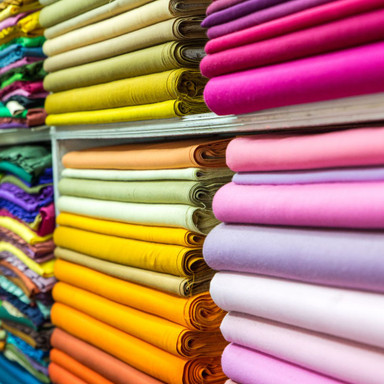Posted by Wicked Fabrics - Vivi Richards on 7th Dec 2023
Introduction: Woven Fabric - What You Need To Know About the Three Types of Woven
Read Time: 5m 30s
Woven fabrics are among the most popular fabrics used for sewing. They are made by interlacing two sets of yarn, warp, and weft, to create a stable fabric. Woven fabrics are versatile and can be used for a variety of sewing projects, from dresses to home décor. In this post, we will explore the three types of woven fabrics you need to know about.
Plain Weave
Plain weave woven fabric is a type of fabric that is made using a simple over-under weaving technique. This technique creates a fabric that has a balanced and uniform appearance on both sides. The fabric is strong, durable, and easy to care for, making it a popular choice for everyday clothing.
It is also known for its breathability, as air can easily circulate through the loose weave structure. This makes plain weave woven fabric a great choice for warm weather clothing.
Plain weave woven fabric is typically made from natural fibres such as cotton, linen, and silk. However, it can also be made from synthetic fibres like polyester and nylon.
There are several types of plain weave woven fabric, each with its own unique characteristics. Some common types include:
- Cotton Broadcloth: a tightly woven plain weave fabric that is soft and durable
- Linen Lawn: a lightweight plain weave fabric that is crisp and breathable
- Silk Taffeta: a smooth and lustrous plain weave fabric that is often used for formal wear
One thing to keep in mind when sewing with plain weave fabrics is that they may fray easily.
Twill Weave
Twill weave woven fabric has several distinctive characteristics. Firstly, it has a diagonal pattern that is formed by the interlacing of warp and weft yarns. This diagonal pattern creates a unique texture and appearance that can vary depending on the angle of the diagonal. Secondly, twill weave fabric is known for its durability and strength due to the tight interlacing of the yarns. Lastly, twill weave fabric is often used in clothing and upholstery due to its ability to drape well and its resistance to wrinkles.
Overall, the characteristics of twill weave woven fabric make it a versatile and popular choice for a variety of applications.
Twill weave fabrics come in a variety of weights and textures, from lightweight denim for shirts to heavy canvas for bags and upholstery. They are also available in a variety of patterns, including herringbone and diamond.
There are several types of twill weave, each with its own unique characteristics. The most common types of twill weave are:
- 2/1 Twill: This is the simplest and most common twill weave, where one weft yarn goes over two consecutive warp yarns, then under one
- 3/1 Twill: This is similar to 2/1 twill, but with an extra weft yarn going over three consecutive warp yarns, then under one
- Herringbone Twill: This is a type of twill weave that creates a zigzag pattern that resembles the bones of a herring. It is commonly used in clothing and home décor.
When sewing with twill weave fabrics, keep in mind that they may be prone to puckering. Use a walking foot or a heavy-duty needle to prevent puckering.
Satin Weave
Satin weave is a type of weave that creates a smooth and shiny fabric. It is characterised by its long floats, which are the threads that run over several other threads before being interlaced. This creates a lustrous and smooth surface, which is why satin fabrics are often used for formal wear and special occasions.
Satin weave can be made with a variety of different fibres, including silk, cotton, polyester, and rayon. Each fibre will lend its own unique properties to the fabric, such as silk's natural shine or cotton's breathability.
The history of satin weave dates back to ancient China, where silk fabrics were first woven using this technique. Satin fabrics were considered a luxury item and were often reserved for royalty or the wealthy.
Over time, satin fabrics became more accessible and were used for a wider range of applications. Today, satin weave fabrics are used for everything from clothing to upholstery to bedding.
Satin weave fabrics come in a variety of weights and textures, from lightweight silk for dresses to heavy crepe for jackets and skirts. They are also available in a variety of colours, from bright and bold to soft and pastel.
There are several different types of satin weave, each with its own unique characteristics. Some of the most common types of satin weave include:
- Charmeuse - a lightweight, drapey satin fabric often used for blouses or lingerie.
- Crepe-Back Satin - a heavier, more structured satin fabric with a matte finish on one side and a shiny finish on the other.
- Duchess Satin - a heavyweight, luxurious satin fabric often used for wedding gowns or formal wear.
When sewing with satin weave fabrics, keep in mind that they may be prone to snagging and fraying. Use a sharp needle and handle the fabric with care to prevent snags.
Choosing the Right Fabric for Your Project
When choosing a woven fabric for your project, consider the weight, texture, and pattern of the fabric. Lightweight fabrics like cotton and silk are ideal for summer dresses, while heavy fabrics like denim and canvas are ideal for jackets and pants.
Texture is also an important factor to consider. Smooth, shiny fabrics like satin are ideal for special occasion wear, while textured fabrics like tweed and boucle are ideal for jackets and skirts.
Preparing Your Fabric
Before you start sewing, it's important to prepare your fabric. This includes prewashing and ironing your fabric to remove any sizing or wrinkles.
To prewash your fabric, simply wash it in cold water and tumble dry on low heat if fabric permits. This will remove any sizing or chemicals that may be on the fabric and prevent shrinkage later on.
After prewashing, iron your fabric to remove any wrinkles. This will make it easier to cut and sew your fabric later on.
Cutting Your Fabric
Cutting your fabric is an important step in the sewing process. Make sure to use sharp scissors or a rotary cutter to ensure clean, straight edges.
When cutting your fabric, make sure to follow the grainline. The grainline is the direction of the warp yarns, and it is important to follow it to ensure that your fabric hangs and drapes correctly.
Finally, make sure to mark your fabric with tailor's chalk or a fabric pen to indicate the pattern pieces and any notches or darts.
Sewing Your Fabric
When sewing your fabric, use a straight stitch or a zigzag stitch depending on the fabric weight and texture. A straight stitch is ideal for lightweight fabrics, while a zigzag stitch is ideal for heavy fabrics.
Make sure to use the correct needle for your fabric type and weight. A universal needle is ideal for most woven fabrics, while a denim needle is ideal for heavy fabrics like denim and canvas.
Finally, finish the edges of your fabric with a zigzag stitch, overlocker, or bias tape to prevent fraying.
Pressing Your Fabric
Pressing your fabric is an important step in the sewing process. It helps to set the seams and create a professional-looking finish.
Use a hot iron on the appropriate setting for your fabric type and weight. Press the seams flat, and then press them open or to one side depending on the pattern instructions.
Finally, use a pressing cloth to protect your fabric from scorching or melting.
Woven fabrics are versatile and can be used for a variety of sewing projects. By understanding the three types of woven fabrics and how to sew with them, you can create beautiful garments and home décor items that will last for years to come.
Remember to choose the right fabric for your project, prepare your fabric properly, and use the correct stitching and finishing techniques to ensure a professional-looking finish.



